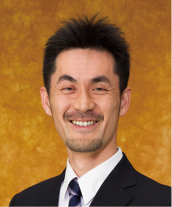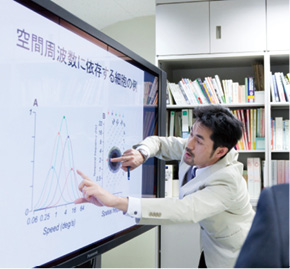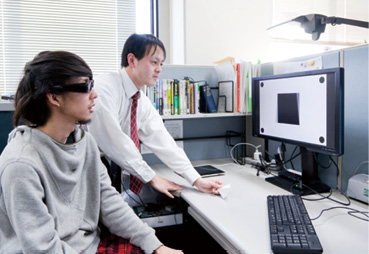
As of August, 2015
| Faculty/Department | Department of Human Media Systems Graduate School of Information Systems |

|
| Members | Shunji Satoh, Associate professor | |
| Affiliations | Japanese Neural Network Society; Institute of Electronics, Information and Communication Engineers; Institute of Electrical and Electronics Engineers (IEEE); Vision Society of Japan | |
Visual perception; brain; information processing; human informatics; simulations; input/output of brain; digitization; mathematization; parallel distributed processing system; image processing; psychophysical experiments
Our laboratory pursues research in human informatics, a field of study that seeks to elucidate human information processing mechanisms. We focus on visual perception. From the perspective of image engineering, we are currently examining how sophisticated functions such as pattern recognition emerge and exploring some of the curious properties of human visual perception, including optical illusions. We are developing novel image processing techniques that draw on the properties of human visual perception and actively pursuing research that integrates engineering and science. In preparation for research to elucidate visual perception, our laboratory has undertaken various psychophysical experiments intended to investigate the information processing that takes place in the whole brain. These experiments involve presenting various patterns to subjects and examining how the brain “sees” the patterns. These experiments help shed light on the information processing associated with human visual perception, an area where a complete understanding remains out of reach.
In certain ways, the human visual perception system resembles a camera. Light passes through a lens called the crystalline lens, creating images on the retina, which we can compare to a film or charge-coupled device (CCD) sensor. This information is ultimately relayed to the brain, which we can liken to an image processing computer.

However, human visual perception is not as perfect as the camera. Every eye has a blind spot where optic nerves pass through the retina. This area lacks photoreceptor cells and is unable to respond to light. Although this blind spot is incapable of detecting any part of an image, the brain fills in the blind spot to complete the image. Other curious aspects of human visual perception are reflected by the phenomenon of optical illusions, whereby we may perceive color in black-and-white images or see apparent motion where none exists. These strange and unique phenomena are part of human visual perception. Associate Professor Satoh seeks to create mathematical models of these two phenomena, blind spot completion and optical illusions, to apply the results to creating image processing techniques and develop software that will allow him to perform computer simulations of human visual perception.
The human visual perception also exhibits certain remarkable strengths, including its capacity to distinguish characters from images. Even the most expensive character recognition system currently available will sometimes see characters in places where none are present and proceed to process them as if they were characters.
The human eye never makes such errors; humans instantly recognize and identify characters and images.
Associate Professor Satoh has studied the mechanisms of human visual perception since 2004.
The key strength of our laboratory is our approach to human visual perception as an image processing function and our attempts to describe human visual perception mathematically.
More specifically, what sets us apart from other laboratories is that we take an engineering approach to identifying mathematical models of the image processing performed by the brain based on numerical data obtained through experiments. This process involves repeated experimentation to study the output from the brain for a given input, with a special focus on the functions of the brain as it performs visual image processing; reviewing the numerical data obtained; and creating mathematical expressions to model the phenomena occurring in the brain.
For example, we compare the numerical data for the input (electric current) and output (voltage). Based on our assumption that our brain cells integrate and differentiate this data, we draw on experience, knowledge, intuition, and imagination to devise mathematical expressions. Expressing human visual information processing mathematically is a step toward the goal of creating computer programs that embody human visual functions. Creating software capable of reproducing the functions and properties of human visual perception in the form of mathematical expressions will result in a computer that has human visual characteristics. Success in this endeavor would result in a platform for performing computer simulations of human visual perception, allowing us in turn to accurately predict the response triggered to a given visual stimulus in humans without actual human participation.
We have developed a blind spot completion program as an application of the human visual function.
Since the program fills in the region lacking image data through association with images in the surrounding area, it can be used to restore images with missing portions. Our program has won plaudits for superior performance compared to existing software. The research paper titled “Computational theory and applications of a filling-in process at the blind spot” by Satoh and Usui that presents this program won the best paper award in 2009 from the Japanese Neural Network Society, and RIKEN has sent the authors a certificate of appreciation. Our series of studies of visual perception have been recognized by the 2010 APNNA Young Researcher Award.
The human visual perception has a wide range of functions, including pattern, movement and shape recognition; stereoscopic vision; and selective attention.
The results of numerous past experiments have uncovered the complex nature of visual perception. Associate Professor Satoh is focusing on establishing mathematical expressions that will provide an elegant explanation for these complexities from an engineering perspective.

The sections above summarize what happens in the brain in response to phenomena associated with visual phenomena. However, even for a single discrete phenomenon, information processing is not performed by single brain cells, but by areas of the brain.
For examples, one area of the brain specializes in facial recognition; another handles movement recognition. Nor is the image processing required to process visual inputs confined to a single area of the brain. At our laboratory, in addition to studies to establish the mathematical expressions for the image processing taking place in each area, we perform simulations using the mathematical expressions to identify through which areas of the brain the signals pass. Our ultimate goal is to develop software capable of simulating the functions of the whole brain by combining the mathematical expressions established for each area. Once completed, this will allow us to engage in joint simulation studies of the brain with researchers in Japan and from abroad.
The properties and mechanisms of visual perception, including the phenomenon of optical illusions, have yet to be fully understood. Some theories maintain the visual perception results from cellular malfunctions, while others claim that visual perception is the byproduct of complex image processing within the brain.
To clarify the factors underlying these phenomena and to simulate them, we need to represent the brain’s image processing functions in mathematical form. Nevertheless, in light of the extreme complexity and difficulty of simulating the mechanisms (functions) of visual information processing throughout the brain, we plan to begin by building a platform for programming brain-associated functions. Using this platform, we hope to undertake joint research with other researchers to achieve our ultimate goal.
Once the mechanism of visual perception has been uncovered, our goal is to develop a device capable of distinguishing characters from images, a longstanding research theme.

